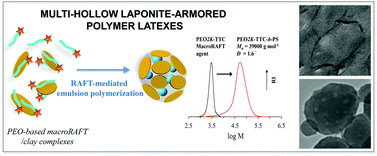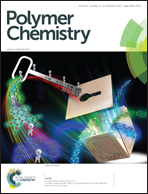Synthesis of multi-hollow clay-armored latexes by surfactant-free emulsion polymerization of styrene mediated by poly(ethylene oxide)-based macroRAFT/Laponite complexes†
Abstract
We report the surfactant-free emulsion polymerization of styrene mediated by a trithiocarbonate poly(ethylene oxide)-based macromolecular RAFT agent (PEO2K-TTC, Mn(PEO) = 2000 g mol−1) in the presence of Laponite clay platelets. Adsorption studies revealed high affinity of the macroRAFT for Laponite. The resulting macroRAFT/clay complexes were used to control the growth of polystyrene chains and generate clay-armored latexes. Undesirable effects observed under the same conditions in the absence of clay, such as rate retardation, a long induction period and loss of colloidal stability, were not observed when the macroRAFT was immobilized on the clay surface. A minimum amount of macroRAFT was necessary to ensure a good control of the polymerization and a narrow molar mass distribution while a too large amount led to similar effects as in the absence of clay due to partitioning of the free non-adsorbing PEO2K-TTC macroRAFT. By a careful selection of the macroRAFT and monomer concentrations, stable multi-hollow clay-armored composite latex particles containing embedded PEO and composed of polymer chains of controlled and narrowly distributed molar masses could be successfully obtained by this technique.


 Please wait while we load your content...
Please wait while we load your content...